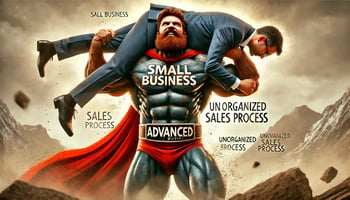The Pipeline-First Paid Search Playbook: Stop Wasting Budget on Clicks. Start Winning Sales Opportunities.
Let's be honest: most B2B paid search programs are a vanity project.
They generate impressive-looking dashboards full of clicks, low CPLs, and a steady stream of "demo request" conversions. Marketing reports "success," but the sales team tells a different story. They're drowning in "leads" from students, curious researchers, and 2-person startups who are just educating themselves on the market.
This is the fundamental disconnect in B2B marketing. We've been taught to optimize for the form fill, not the revenue outcome.
Our philosophy is simple, and it's built for "ops" minded leaders: A keyword is only good if it converts to a real sales opportunity.
We don't care about clicks. We barely care about demo requests. We care about pipeline.
We've found that the vast majority of search volume is educational. Bidding on broad, two-word terms like "cloud software" is just paying for Google's R&D. The real success, the kind that translates to closed-won deals, comes from long-tail, hyper-specific keywords that align perfectly with how your Ideal Customer Profile (ICP) is actually shopping.
Search is a capture channel. Your job is to capture the tiny fraction of the market that is actively in-market and is a perfect fit for your product. This playbook shows you how to stop wasting money on the rest.
The Anatomy of a "Leaky" Paid Search Account
We see the same pattern in 9 out of 10 B2B accounts we audit. The CPL looks great (say, $150), but the Cost-per-Sales-Qualified-Opportunity is $5,000... or worse, it's untrackable.
The problem isn't the platform; it's the strategy. Here’s what we typically find:
-
You're Measuring the Wrong "Conversion": Your primary conversion goal is "Lead Form Submit." This tells Google's algorithm to find you more people who are good at filling out forms. It does not tell Google to find you people who match your ICP and have budget and authority.
-
Your Structure Serves Google, Not You: Your campaigns are organized by product name or generic themes. This forces you to lump high-intent keywords ("best enterprise accounting software for manufacturing") in with low-intent research queries ("what is cloud accounting"). You can't control your budget, so Google's Smart Bidding spends it for you—often on the high-volume, low-quality clicks.
-
Your Intent Filters Are Non-Existent: You're bidding on any keyword that feels relevant. But you're forgetting that for every one person searching to "buy," 100 are searching to "learn."
The 3 Core Problems Plaguing Your Paid Search
-
Wasted Spend on "Researchers": You pay for clicks from users searching "how to," "examples," "templates," or "what is." These are not buyers. They are students, analysts, or competitors. You are paying to educate them.
-
Wrong Structure (ICP-Blind): Your campaigns don't differentiate between your ICP and the rest of the world. A "demo request" from a 5-person startup (your non-ICP) is treated the same as a demo request from a 5,000-person enterprise (your ICP). This is programmatic waste.
-
Bad Measurement (MQL-Focused): You report on Cost-Per-Lead (CPL). This is the most dangerous vanity metric in B2B. A $50 lead that never converts is infinitely more expensive than a $500 lead that turns into a $50,000 sales opportunity.
The Pipeline-First Paid Search Framework
This is the system we use to fix leaky accounts and build programs that generate real revenue.
1. Fix Your Tracking (The "Ops" Foundation) This is the most important step. If you get this wrong, nothing else matters.
-
Connect Your CRM: Your Google Ads account must be connected to your CRM (Salesforce, HubSpot, etc.).
-
Define Your Real Conversion: Create a new primary conversion action in Google Ads. Do not call it "Lead." Call it "Sales-Qualified Opportunity" or "Pipeline-Created."
-
Import Your Opportunities: Set up an offline conversion import for your CRM "Opportunity Created" stage. This is your new North Star. The "Demo Request" form fill should be set as a "Secondary" action.
-
Why? This teaches Google's algorithm to stop finding leads and start finding opportunities. You are now optimizing for pipeline, not form fills.
2. Hunt for Long-Tail, ICP-Specific Keywords Stop bidding on broad, expensive head terms. Go to your Search Query Report (SQR) and look for the 5-to-10-word phrases that are driving your actual sales.
-
Bad: "CRM software"
-
Good: "CRM software for mid-market SaaS companies"
-
Better: "Best CRM for SaaS with [X] integration" These long-tail keywords have low volume, but their intent is surgical. Every click is from a user who has pre-qualified themselves.
3. Build a Fortress of Negative Keywords Be ruthless. Your goal is to prevent 90% of searchers from seeing your ads.
-
Irrelevant Traffic:
free,careers,templates,examples,tutorial,what is,how to,jobs. -
Non-ICP Traffic: If you sell to enterprises, add negatives like
small business,startup,personal. -
Low-Intent Tokens: Remove terms like
guide,report,whitepaperfrom your high-intent capture campaigns. Put them in a separate, low-budget "Content" campaign if you must.
4. Restructure by Intent + ICP Don't group by product. Group by buyer intent and ICP segment.
-
Campaign 1: Branded (Your company name)
-
Campaign 2: High-Intent - Enterprise ICP (e.g., "enterprise sales ops platform")
-
Campaign 3: High-Intent - SMB ICP (e.g., "sales ops software for small business")
-
Campaign 4: Competitor (e.g., "salesforce alternative") This structure gives you full control. You can now allocate 80% of your budget to your most profitable ICP segment (e.g., Campaign 2) and know that every dollar is aimed at pipeline.
5. Choose the Right Bidding Approach (For Pipeline) Do not turn on Smart Bidding (like Target CPA) right away. Your account is full of bad data (MQLs).
-
Start: Begin with Manual CPC or Enhanced CPC. Your goal is to gather data—pipeline data.
-
Scale: Once your new "Sales-Qualified Opportunity" conversion has at least 30 conversions per month, you can test a Target CPA (Cost-per-Opportunity) strategy.
-
Win: Your new tCPA target won't be $150. It might be $2,000. But if your average deal size is $40,000, you'll be printing money while your competitors are still bragging about their $150 CPL.
What to Expect When You Make This Change
When you shift from a "lead-gen" to a "pipeline-first" model, your dashboards will change dramatically. You need to prepare your team for this.
-
Your Total Leads will Drop. Possibly by 50-80%. This is a good thing.
-
Your Cost-Per-Lead (CPL) will go Up. This is also a good thing. You're filtering out the cheap, junk leads and paying a premium for high-intent, ICP-fit prospects.
-
Your Sales Team's Morale will Skyrocket. They will finally be getting "leads" that are actually opportunities.
-
Your Cost-Per-Opportunity (CPO) will go Down.
-
Your Customer Acquisition Cost (CAC) will go Down.
You'll have fewer leads, but they'll be better. You'll stop wasting budget on clicks that go nowhere and start investing in keywords that turn into revenue.
Stop reporting on CPL. Start reporting on pipeline. That's how you build a paid search program that actually works.
________
Ready to See Your Real Cost-Per-Opportunity?
If this blog felt familiar, your ad account is likely leaking budget.
Let's run a free, 30-minute Pipeline Audit on your paid search program. We'll show you exactly where the waste is and build a plan to fix it.
Schedule a Call Now


